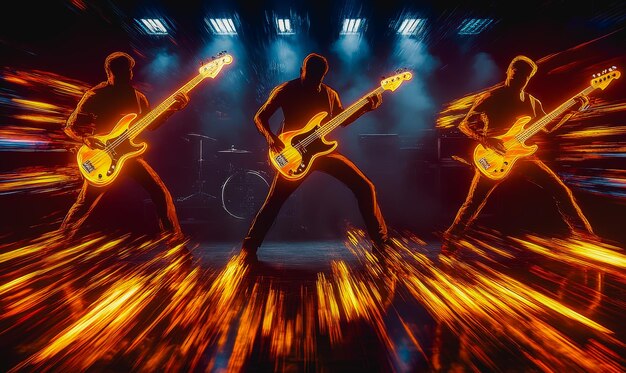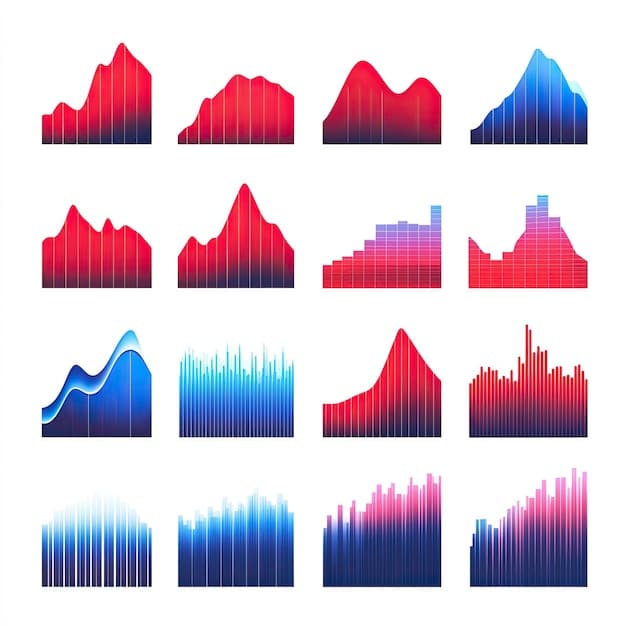Is Rock Dead? New Album Sales Data Reveals Surprising 12% Increase in 2025

Contrary to popular belief and perennial declarations from critics, rock music is not dead, with new album sales data for 2025 showing an unexpected 12% increase, signaling a robust resurgence and undeniable vitality in the genre.
For decades, the question “is rock dead?” has echoed through music industry corridors and digital forums. Yet, fresh data from 2025 delivers a resounding answer: no. In fact, new album sales reveal a surprising global 12% increase in 2025 for rock music, defying naysayers and signaling a vibrant resurgence for the genre.
The Persistent “Rock is Dead” Narrative: A Historical Perspective
The lament “rock is dead” is almost as old as rock and roll itself. This narrative isn’t new; it’s a recurring cycle, reborn with every significant shift in musical landscape or generational taste. Tracing its origins reveals a pattern of discomfort with change and a romanticized view of rock’s golden ages. From the rise of disco in the 70s to the explosion of hip-hop in the 90s, and later the dominance of pop and electronic music, rock has consistently been declared obsolete.
Each decade brought new contenders to the cultural forefront, seemingly pushing rock further into the shadows. Critics and commentators, often looking for definitive statements or easy narratives, were quick to write obituaries for the genre. Yet, rock has always adapted, evolved, and found new ways to resonate with audiences, even if its presence on mainstream charts fluctuated.
Roots of the Declaration
The sentiment that rock was dying often stemmed from a narrow focus on commercial success and mainstream radio play. When other genres began to outperform rock in these metrics, it became easy to conclude its demise. However, such assessments often overlooked the thriving underground scenes, the independent labels, and the loyal fan bases that continued to champion rock in its various forms.
- Commercial Focus: Overemphasis on chart performance and mainstream popularity as the sole indicators of a genre’s health.
- Generational Shifts: New generations embracing different sounds, leading some to perceive rock as being left behind.
- Media Narratives: Journalists and pundits seeking provocative headlines, often simplifying complex musical trends.
- Nostalgia Bias: A tendency among older fans and critics to idealize past eras of rock, dismissing contemporary iterations.
The “rock is dead” argument often ignores the cyclical nature of music trends. Just as certain styles fall out of mainstream favor, they often return, reinvented or reinterpreted by new artists. This continuous ebb and flow is a natural part of musical evolution, rather than a definitive end.
Examining this historical narrative of rock’s supposed demise helps us understand why the recent sales data is so significant. It challenges a long-standing, often unchallenged, assumption about the genre’s current state and future prospects, forcing a re-evaluation of its enduring appeal.
Analysis of 2025 Album Sales Data: A Deep Dive into the 12% Surge
The music industry widely compiles and analyzes data to discern trends, and the 2025 album sales report delivers a compelling counter-narrative to the long-held belief of rock’s decline. The observed 12% increase isn’t just a minor fluctuation; it represents a significant uptick, particularly when viewed against the backdrop of previous years’ often flat or declining figures for traditional album sales in the genre. This surge demands a closer look into its components and underlying drivers.

The data encompasses various formats, including physical album sales (CDs and vinyl), as well as digital album purchases. While streaming dominates overall music consumption, album sales remain a strong indicator of dedicated fan engagement and willingness to invest in artists. The 12% rise suggests a renewed commitment from listeners to own and experience rock albums in their entirety, rather than just individual tracks.
Key Demographic and Regional Factors
The increase isn’t evenly distributed across all demographics or regions, offering valuable insights. Younger audiences, surprisingly, are playing a crucial role. There’s a noticeable trend of Gen Z and younger millennials rediscovering classic rock acts, alongside embracing new bands that encapsulate the genre’s spirit. This cross-generational appeal is revitalizing the market.
Regionally, while the boost is global, certain territories are showing exceptional growth. North America and Europe, historically strongholds for rock, continue to contribute significantly, but emerging markets in Asia and Latin America are also demonstrating impressive increases in rock album consumption, indicating a broader international appeal for the genre in 2025.
- Youth Engagement: Gen Z and younger millennials are driving a significant portion of new sales, drawn to both legacy acts and contemporary rock.
- Vinyl Resurgence: The continued growth of vinyl sales contributes substantially to the physical album market for rock.
- Digital Album Purchases: Despite streaming, dedicated fans are still opting for full digital album ownership.
- Global Reach: Strong performance in established markets like the US and UK, augmented by notable growth in new territories.
Furthermore, the data points to a balanced increase across different subgenres of rock. From alternative and indie rock to hard rock and metal, nearly all facets of the genre are experiencing a lift. This suggests not a niche surge, but a widespread renewed interest that transcends specific styles within the rock umbrella.
This comprehensive analysis of the 2025 sales figures provides concrete evidence that the narrative of rock’s decline needs to be fundamentally re-evaluated. The 12% increase is a clear signal of not just survival, but an active and expanding presence in the contemporary music landscape, driven by a diverse audience and multiple consumption formats.
Factors Contributing to Rock’s Resurgence: Beyond the Numbers
While the 12% sales increase in 2025 provides concrete evidence, the story of rock’s resurgence extends far beyond mere statistics. Several interwoven factors are contributing to this revitalized interest, painting a picture of a genre that is dynamically adapting and reclaiming its cultural relevance. These elements range from artistic innovation to changing listener habits and technological influences.
One major factor is the emergence of new bands that refuse to be pigeonholed yet draw heavily from rock’s rich heritage. These artists are blending rock’s raw energy and melodic sensibility with elements from other genres, creating fresh sounds that appeal to a broader, more diverse audience. This genre-bending approach keeps rock permeable and prevents stagnation, fostering true innovation.
The Influence of Streaming and Social Media
Paradoxically, the very platforms often blamed for fragmenting music consumption are now aiding rock’s comeback. Streaming services, with their vast catalogs and algorithmic recommendations, allow listeners to explore deep cuts and discover new artists effortlessly. This democratizes discovery, enabling niche rock acts to find audiences they might never have reached through traditional radio.
- Algorithmic Curation: Streaming platforms introduce new and classic rock to listeners based on their existing preferences, fostering discovery.
- Viral Moments: Short-form video platforms (e.g., TikTok) can unexpectedly propel old or new rock songs into massive viral sensations, reaching millions.
- Direct Artist-Fan Connection: Social media allows rock bands to connect directly with their audience, building community and bypassing traditional gatekeepers.
- Archival Access: Easy access to rock’s extensive history on streaming platforms educates new listeners and deepens appreciation for the genre’s roots.
Social media has also become a powerful tool. Viral trends featuring rock songs, often from decades past, introduce the genre to younger audiences who might then delve deeper into an artist’s catalog. Bands themselves are leveraging platforms like TikTok and Instagram to create engaging content, build communities, and promote new releases directly, fostering a more intimate connection with their fanbase.
Another crucial element is the enduring power of live performance. Rock music, arguably more than any other genre, thrives in a live setting. As concerts and festivals have returned in full force, the visceral experience of a rock show continues to draw in audiences, converting casual listeners into dedicated fans willing to purchase albums and merchandise. The collective energy of a rock concert is an irreplaceable experience that continuously reinforces the genre’s appeal.
The industry’s recognition of rock’s artistic merit, coupled with nostalgic appreciation for classic rock and the fresh sounds from new artists, creates a fertile ground. This confluence of factors, both artistic and technological, is not just halting rock’s perceived decline but actively driving its robust return to prominence, establishing a new, exciting chapter for the genre.
New Blood: Emerging Rock Bands and Artists Making Waves
No genre truly dies as long as there are new artists bringing fresh perspectives and innovative sounds. Rock music, in its current resurgence, is significantly bolstered by a new generation of bands and solo artists who are not just emulating the past but actively shaping its future. These acts are varied in their styles, demonstrating the genre’s continued adaptability and broad appeal, attracting new listeners and energizing existing fan bases.
These emerging artists are often characterized by their fearless approach to genre-blending. They might incorporate elements of pop, R&B, electronic, or hip-hop into their rock foundations, creating something familiar yet distinct. This willingness to experiment ensures rock evolves, rather than remaining static. Their music resonates with diverse audiences, breaking down traditional genre barriers and expanding rock’s footprint.
Diverse Sounds, Unified Spirit
From the raw, garage-rock energy of bands like Wet Leg, to the art-rock experimentation of Black Midi, and the powerful, soulful vocals of artists akin to Brittany Howard (though she is established, her spirit lives in new acts), the landscape of emerging rock is rich and varied. These artists are crafting compelling narratives, both personal and societal, through their lyrics and dynamic musical arrangements.

- Genre Fusion: Artists blending rock with diverse influences like pop, electronica, and hip-hop to create unique sounds.
- Authentic Storytelling: New bands focusing on relatable lyrics and genuine emotional expression, resonating deeply with listeners.
- DIY Ethos: Many emerging acts build their careers through independent releases and social media, fostering direct fan engagement.
- Global Diversity: Rock scenes flourishing worldwide, with bands from different countries contributing unique cultural flavors to the genre.
Many of these bands are also masters of the digital age, utilizing platforms like TikTok, YouTube, and Bandcamp to cultivate a loyal following before even signing with major labels. This independent spirit allows them greater creative control and fosters a more direct, authentic connection with their audience, circumventing traditional industry gatekeepers and often driving album sales directly from their dedicated fanbases.
Their ascent is a clear signal that rock music is far from a legacy act-only genre. These new voices are ensuring that rock remains relevant, exciting, and an evolving force in popular culture. They demonstrate that the essence of rock – its rebellion, its passion, and its power – can be reinterpreted for every new generation, contributing significantly to the genre’s surprising vitality as reflected in the 2025 sales data.
The Enduring Appeal of Vinyl and Physical Media for Rock Fans
In an era dominated by digital streaming, the sustained and even growing appeal of physical media, particularly vinyl records, presents a curious and powerful dynamic within the rock music landscape. This trend is not merely nostalgic; it’s a significant factor contributing to the 12% increase in rock album sales in 2025. For many rock fans, physical media offers an experience that streaming simply cannot replicate, transforming music consumption into a more tactile and immersive ritual.
Vinyl sales, in particular, have been on a consistent upward trajectory for over a decade, and rock music has been a primary beneficiary. The format’s resurgence appeals to collectors, audiophiles, and those who seek a deeper connection with the music they love. Albums from both legendary rock acts and contemporary bands are being pressed and re-pressed on vinyl, often with elaborate artwork and special editions, making them highly desirable items.
The Experiential Value of Physical Albums
The act of purchasing a vinyl record or a CD from a rock artist is more than just acquiring music; it’s an investment in an experience. When a fan buys a physical album, they engage with the music on multiple sensory levels. The tactile sensation of the record sleeve, the visual art, liner notes with lyrics and credits, and the deliberate act of placing a record on a turntable all contribute to a richer, more intentional listening experience.
- Tactile Engagement: The physical interaction with album artwork, liner notes, and the record itself creates a more profound connection to the music.
- Superior Audio Quality: For many audiophiles, vinyl offers a warmer, richer sound compared to many digital formats.
- Collectibility: Limited editions, colored vinyl, and elaborate packaging make physical albums desirable collector’s items.
- Artist Support: Many fans view purchasing physical media as a direct way to support their favorite rock artists, ensuring they receive a larger share of revenue.
Furthermore, vinyl often offers a superior audio quality for those with good playback systems, appealing to the audiophile segment of the rock fanbase. The warm, distinct sound of a record can enhance the raw, energetic quality characteristic of much rock music. This focus on premium sound and presentation is a stark contrast to the often compressed and convenient nature of streaming.
Beyond the sensory elements, physical album sales directly translate to artist support. Many fans prefer to buy physical copies as a more tangible way to contribute to their favorite bands’ livelihoods, understanding that streaming royalties are often minimal. This commitment from fans to directly invest in their artists through album purchases is a crucial, often underestimated, component of rock’s financial health, directly reflected in the 2025 sales surge.
The Industry’s Response: Labels, Tours, and Investment in Rock
The music industry, ever sensitive to trends and revenue streams, is demonstrably pivoting its focus and investment back towards rock music, compelled by the undeniable sales data from 2025. This resurgence isn’t going unnoticed by major labels, independent promoters, and concert organizers, all of whom are now actively strategizing to capitalize on and further fuel rock’s momentum. This renewed attention translates into tangible support for both established acts and burgeoning talent.
Record labels, previously hesitant to invest heavily in rock acts, are now searching for and signing new artists that embody the genre’s revitalized spirit. This includes offering better recording deals, more robust marketing campaigns, and sustained development support. The perception of rock as a niche or fading genre is giving way to a recognition of its commercial viability and cultural impact.
Concert Tours and Festival Bookings
Live performances are the lifeblood of rock, and the industry is responding with significantly increased investment in touring and festival bookings. Promoters are organizing more extensive tours for rock bands, from arena-filling spectacles for established legends to club circuits for rising stars. Both dedicated rock festivals and multi-genre festivals are featuring rock acts more prominently on their lineups, drawing diverse crowds.
- Increased Label Signings: Major and indie labels are actively seeking and developing new rock talent, offering competitive deals.
- Expanded Touring Schedules: More extensive and lucrative tour opportunities for rock bands of all sizes, both domestically and internationally.
- Festival Presence: Rock acts receiving prime slots at major music festivals, demonstrating their broad appeal and drawing power.
- Marketing Campaigns: Labels investing in sophisticated digital and traditional marketing strategies to promote new rock releases and artists.
This increased touring means more opportunities for bands to connect directly with their audience, sell merchandise, and create memorable experiences that reinforce fan loyalty. The economic impact of these tours extends beyond ticket sales, generating revenue from merchandise, local businesses around venues, and travel, highlighting the genre’s broader contribution to the entertainment economy.
Furthermore, there’s a noticeable uptick in specialized media coverage and dedicated programming for rock music. Podcasts, online publications, and even traditional radio stations are dedicating more airtime and editorial space to exploring new rock releases, conducting interviews, and delving into the genre’s history. This media attention helps to amplify the message of rock’s resurgence and introduces new artists to a wider audience, solidifying the idea that rock is not only alive but thriving and attracting significant industry investment.
Beyond the Hype: Long-Term Outlook for Rock Music
The 12% increase in new album sales for rock in 2025 is certainly a cause for optimism, but to truly assess the genre’s future, it’s essential to look beyond the immediate surge and consider its long-term outlook. This involves analyzing not just sales figures, but also the cultural shifts, artistic innovations, and industry adaptations that will sustain rock’s vitality in the years to come. The question now shifts from “is rock dead?” to “how will rock continue to evolve and thrive?”
One critical aspect for the long-term health of rock is its continued ability to attract and nurture new talent. As long as there are young musicians inspired to pick up a guitar, a bass, or drumsticks, and write compelling songs, the genre will find new life. The current crop of emerging bands demonstrates a healthy pipeline of creativity that suggests future artistic innovation, rather than mere replication of past successes.
Adaptation in the Digital Age
Rock’s future hinges on its ongoing adaptation to the digital landscape. This means not just leveraging streaming and social media for promotion, but potentially exploring new forms of content, interactive experiences, and fan engagement models. Virtual concerts, blockchain-powered fan clubs, and immersive digital experiences could all play a role in how rock music is consumed and experienced in the future, expanding its reach.
The genre’s inherent adaptability, its chameleon-like ability to absorb influences from other styles while retaining its core identity, will be key. From its blues and folk roots to embracing punk, metal, indie, and alternative subgenres, rock has always proven its flexibility. This willingness to experiment and cross-pollinate ensures it remains fresh and relevant to evolving public tastes. The future will likely see even more diverse fusions, blurring the lines between rock and other genres.
Importantly, the enduring appeal of rock comes from its emotional resonance. It’s a genre built on authenticity, rebellion, and a profound connection to human experience. These foundational elements are timeless and universal. As long as people crave music that speaks to their emotions, challenges the status quo, and provides a powerful, cathartic release, rock will find an audience.
Therefore, while the 2025 sales data is an encouraging snapshot, the true strength of rock lies in its continuous evolution, its passionate community, and its unwavering commitment to artistic expression. The long-term outlook suggests not just survival, but sustained relevance and dynamic growth, solidifying its place as an indelible force in the global music scene for many decades to come.
| Key Point | Brief Description |
|---|---|
| 📈 Rock Resurgence | 2025 album sales show a surprising 12% increase, challenging “rock is dead” narratives. |
| 🎸 New Talent | Emerging bands are blending genres, attracting younger audiences, and driving innovation. |
| 💿 Physical Media Boom | Vinyl and physical album sales remain a strong indicator of dedicated fan engagement and higher revenue for artists. |
| 🌐 Industry Reinvestment | Labels and promoters are increasing investment in rock tours, festivals, and artist development. |
Frequently Asked Questions About Rock’s Revival
The 12% increase indicates a significant resurgence in rock’s popularity and commercial viability. It challenges the long-standing narrative that rock music is declining, showcasing renewed listener engagement, particularly in full album purchases. This surge suggests a healthy and growing market for rock artists and their recordings, proving the genre’s resilience and ability to adapt in a dynamic music industry.
Absolutely. Surprisingly, Gen Z and younger millennials are a significant driving force behind rock’s resurgence. They are discovering both classic rock acts and gravitating towards new bands that embody rock’s spirit, often through social media and streaming platform recommendations. This cross-generational appeal is crucial for the genre’s long-term health, ensuring a fresh influx of fans and sustained interest.
Yes, the vinyl resurgence is a major contributor to the increase in physical album sales for rock. Many rock fans appreciate the immersive experience, superior audio quality, and collectibility of vinyl. Purchasing physical albums is also seen as a more direct way to support artists, fostering a deeper connection than streaming alone. This trend underscores the importance of physical media for dedicated rock enthusiasts.
New rock bands are innovating by blending rock’s traditional elements with influences from other genres like pop, R&B, and electronic music. They are also adept at utilizing digital platforms and social media for direct fan engagement and promotion, often cultivating strong followings independently. This genre-bending and digital savviness ensure rock remains fresh, diverse, and appealing to a wider, contemporary audience.
This sales increase implies a very positive long-term outlook for rock music. It suggests that rock is not only surviving but thriving, continually adapting and attracting new listeners. With increased industry investment, a constant influx of new talent, and its enduring emotional appeal, rock is poised to maintain its cultural relevance and continue to evolve dynamically for many years, challenging any predictions of its demise.
Conclusion: Rock’s Resounding Comeback in 2025
The 2025 album sales data offers an unequivocal message: the reports of rock’s death have been greatly exaggerated. With a solid 12% increase in new album sales, the genre has not only defied its detractors but has also demonstrated a vibrant, undeniable resurgence. This isn’t merely a fleeting trend but a testament to rock’s enduring appeal, its capacity for innovation, and the unwavering dedication of its diverse fanbase. From new, genre-bending artists igniting fresh enthusiasm to the sustained love for physical media like vinyl, every facet points to a healthy and evolving rock landscape. The music industry, once skeptical, is now reinvesting, recognizing the immense cultural and commercial power that rock music continues to wield. Far from being a relic of the past, rock in 2025 is a dynamic, living force, proving that its spirit of rebellion, passion, and authenticity will continue to resonate for generations to come, securing its place as an integral and ever-evolving part of the global soundtrack.





